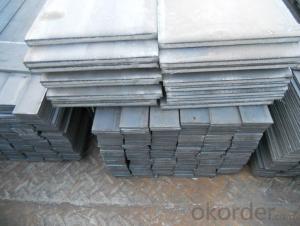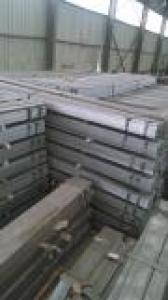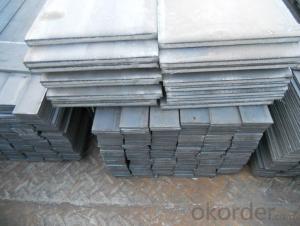Seel Flat Bars with Material Grade Q235 and Good price
- Loading Port:
- Tianjin
- Payment Terms:
- TT OR LC
- Min Order Qty:
- 25 m.t.
- Supply Capability:
- 10000 m.t./month
OKorder Service Pledge
OKorder Financial Service
You Might Also Like
Product Description:
OKorder is offering high quality Flat Bar at great prices with worldwide shipping. Our supplier is a world-class manufacturer of steel, with our products utilized the world over. OKorder annually supplies products to European, North American and Asian markets. We provide quotations within 24 hours of receiving an inquiry and guarantee competitive prices.
Product Applications:
Flat Bars are ideal for structural applications and are widely used in the construction of buildings and bridges, and the manufacturing, petrochemical, and transportation industries.
Product Advantages:
OKorder's Flats Barare durable, strong, and resist corrosion.
Main Product Features:
· Premium quality
· Prompt delivery & seaworthy packing (30 days after receiving deposit)
· Corrosion resistance
· Can be recycled and reused
· Mill test certification
· Professional Service
· Competitive pricing
Product Specifications:
Manufacture: Hot Rolled
Grade: Q195 – 235
Certificates: ISO, SGS, BV, CIQ
Length: 6m – 12m, as per customer request
Packaging: Export packing, nude packing, bundled
Chemical composition of Q235
Alloy No | Grade | Element(%) | ||||
C
| Mn
| S
| P
| Si
| ||
Q235
|
B
|
0.12—0.20 |
0.3—0.7 |
≤0.045 |
≤0.045
|
≤0.3
|
Physical properties of Q235
Alloy No | Grade | Yielding strength point(Mpa) | Tensile strength (Mpa) | Elongation after fracture(%) | ||||||
Thickness (mm) | Thickness (mm) | |||||||||
≤16 | >16--40 | >40--60 | >60--100 | ≤16 | >16--40 | >40--60 | >60--100 | |||
≥ | ≥ | |||||||||
Q235 |
B |
235 |
225 |
215 |
205 |
375--500 |
26 |
25 |
24 |
23 |
FAQ:
Q1: How soon can we receive the product after purchase?
A1: Within three days of placing an order, we will begin production. The specific shipping date is dependent upon international and government factors, but is typically 7 to 10 workdays.
Q2: How do we guarantee the quality of our products?
A2: We have established an advanced quality management system which conducts strict quality tests at every step, from raw materials to the final product.
Q3: What is the normal tolerance of Hot Rolled Mild Steel flat bar?
A3: Normally 7%-9%, but we can also produce the goods according to the customers' requests.
Images:
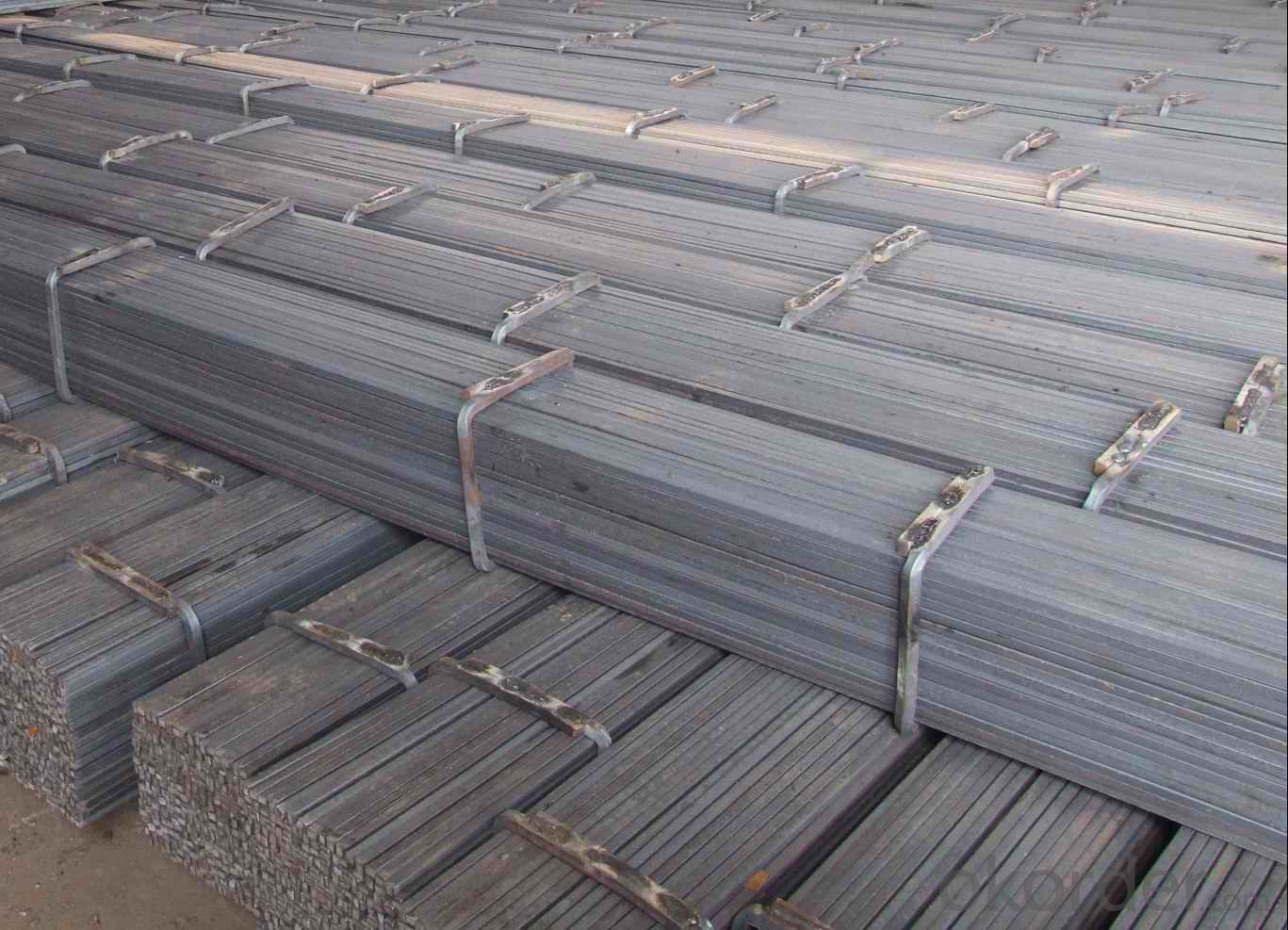
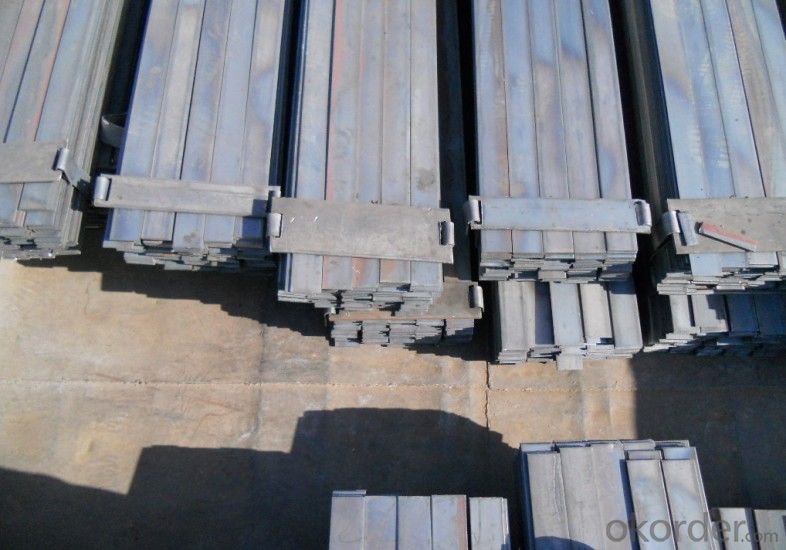
- Q:Can steel flat bars be used for making mining industry equipment?
- Steel flat bars are an excellent choice for the fabrication of mining industry equipment. Being a durable and strong material, steel can withstand the challenging conditions and heavy loads typically encountered in mining. These bars can be utilized in the construction of various mining equipment including conveyor systems, support structures, frames, and components for mining machinery. With their flat shape, they are easy to cut, shape, and weld, making them highly versatile for manufacturing mining equipment. Furthermore, steel flat bars are readily available in different grades and thicknesses, ensuring they can meet the specific requirements of any mining operation. In conclusion, steel flat bars offer a reliable and cost-effective solution for producing mining industry equipment.
- Q:Are steel flat bars commonly used in the furniture industry?
- Yes, steel flat bars are commonly used in the furniture industry. They are versatile and durable, making them an ideal choice for constructing various furniture pieces. Steel flat bars are often used as structural supports or legs for tables, chairs, and other furniture items. They provide stability and strength, ensuring that the furniture can withstand weight and regular use. Additionally, steel flat bars can be easily welded, drilled, and shaped to fit specific design requirements, making them a popular choice for furniture manufacturers and designers.
- Q:How do steel flat bars perform in corrosive or acidic environments?
- Corrosive or acidic environments can affect the performance of steel flat bars, depending on the type of steel and the specific properties of the environment. For instance, stainless steel flat bars offer high resistance to corrosion in most acidic or corrosive environments. This is due to their chromium content of at least 10.5%, which forms a protective oxide layer on the steel surface, preventing further corrosion. Moreover, stainless steel flat bars can be alloyed with elements like nickel or molybdenum to further enhance their corrosion resistance. On the other hand, carbon steel flat bars are not as resistant to corrosion. They are prone to rust and corrosion in acidic or corrosive environments because they lack the protective oxide layer present in stainless steel. In such cases, additional measures like galvanization or coating the flat bars with corrosion-resistant materials may be necessary for protection. To determine the performance of steel flat bars in corrosive or acidic conditions, it is crucial to consider the specific type of steel used and the nature of the environment. Seeking advice from experts or referring to corrosion resistance charts can provide more precise information regarding the suitability of steel flat bars in different environments.
- Q:How is a steel flat bar made?
- The typical method for manufacturing a steel flat bar involves a process known as hot rolling. To begin, a large steel billet or slab is heated to a high temperature, usually around 1200 to 1300 degrees Celsius. Once heated, the billet is then passed through rolling mills where it is gradually flattened and shaped into a long and thin strip called a flat bar. Inside each rolling mill, the steel billet goes through a pair of rotating rolls that apply pressure and reduce its thickness. The billet is rolled multiple times, with the gap between the rolls decreasing after each pass. This continuous rolling process helps to refine the grain structure of the steel, enhancing its strength and durability. Once the desired thickness is achieved, the flat bar may undergo additional processes such as cooling, straightening, and cutting. Cooling is typically done by using air or water to rapidly cool the steel, solidifying its desired properties. Straightening ensures that any bends or twists that occurred during the rolling process are removed, resulting in a uniform flat shape. After the flat bar is cooled and straightened, it is cut into individual lengths using machines designed for shearing or sawing. These lengths can then be further processed or used as is for a variety of applications. In summary, producing a steel flat bar involves heating a steel billet, hot rolling it through rolling mills to achieve the desired thickness, cooling, straightening, and finally cutting it into individual lengths. This process yields a versatile and widely used product that is utilized in industries such as construction, manufacturing, and automotive.
- Q:How do steel flat bars contribute to the overall safety of a structure?
- Steel flat bars contribute to the overall safety of a structure in several ways. Firstly, they provide structural stability and support by effectively distributing and transferring loads, ensuring the integrity of the structure. Steel flat bars are strong and durable, with high tensile strength, which allows them to withstand heavy loads and forces without deformation or failure. Additionally, steel flat bars offer resistance against various environmental factors that can compromise the safety of a structure. Steel is highly resistant to fire, corrosion, and extreme weather conditions, making it a reliable choice for enhancing the longevity and safety of a building. Moreover, steel flat bars are often used in the construction of safety barriers, handrails, and guardrails. These elements are crucial for preventing accidents and falls, particularly in elevated areas or walkways. Steel flat bars provide a sturdy and secure barrier, ensuring the safety of individuals within the structure. Furthermore, steel flat bars are often utilized in seismic-resistant designs. Due to their high strength and flexibility, they can absorb and dissipate the energy generated during an earthquake or other seismic events. This feature greatly enhances the overall safety of a structure by minimizing the risk of collapse or structural damage during such incidents. In conclusion, steel flat bars play a vital role in ensuring the overall safety of a structure. Their strength, durability, resistance to environmental factors, and ability to provide structural stability make them an essential component in the construction industry. Whether it is in supporting loads, constructing safety barriers, or enhancing seismic resistance, steel flat bars contribute significantly to the safety and longevity of structures.
- Q:Are steel flat bars recyclable?
- It is true that steel flat bars can be recycled. Steel is widely known as one of the most frequently recycled materials globally because of its inherent characteristics. Its quality and strength remain intact even after being melted down and repurposed numerous times. By recycling steel flat bars, not only do we contribute to the preservation of natural resources, but we also decrease energy usage and greenhouse gas emissions compared to the production of new steel from raw materials. Recycling centers and scrap yards are available for accepting steel flat bars, providing an environmentally friendly alternative for disposing or repurposing these materials.
- Q:Are steel flat bars available in different shapes, such as round or square?
- No, steel flat bars are not available in round or square shapes. They are specifically designed with a rectangular cross-section, characterized by a long width and a relatively small thickness.
- Q:What are the different methods of corrosion protection for steel flat bars?
- Different methods can be utilized to protect steel flat bars from corrosion, which can occur due to exposure to moisture, chemicals, and other corrosive elements. Some commonly employed techniques include: 1. Coating: A highly effective method involves applying a protective coating, such as paint, epoxy, or zinc-rich compounds, onto the surface of the steel flat bars. This creates a barrier that prevents direct contact and oxidation between the steel and the corrosive environment. 2. Galvanization: Another approach is to coat the steel flat bars with a layer of zinc through a hot-dip process, known as galvanization. This zinc layer acts as a sacrificial anode, corroding before the steel does and providing excellent long-term corrosion resistance. 3. Stainless steel: The use of stainless steel flat bars is yet another method of corrosion protection. Stainless steel contains chromium, which forms a passive oxide layer on the surface, safeguarding the underlying steel from corrosion. This makes stainless steel highly resistant to most corrosive environments. 4. Cathodic protection: Cathodic protection involves connecting the steel flat bars to a sacrificial anode, typically made of a more reactive metal like zinc or aluminum. By doing so, the anode corrodes instead of the steel, effectively shielding it from corrosion. 5. Vapor Corrosion Inhibitors (VCI): VCI involves the use of volatile compounds that release corrosion inhibitors into the air. These inhibitors form a protective layer on the surface of the steel, preventing corrosion. VCI proves particularly useful for the long-term storage or transportation of steel flat bars. 6. Proper storage and maintenance: Ensuring appropriate storage conditions and regular maintenance of steel flat bars is crucial for corrosion protection. This includes keeping the material dry, maintaining suitable temperatures, and avoiding exposure to corrosive substances. When selecting a corrosion protection method for steel flat bars, it is important to consider the specific application, environment, and budget. Consulting experts or professionals in the field can help determine the most suitable method for a particular situation.
- Q:What is the standard thickness of a steel flat bar?
- The standard thickness of a steel flat bar can vary depending on the specific dimensions and requirements. However, common standard thicknesses for steel flat bars range from 1/8 inch to 1 inch.
- Q:Are steel flat bars resistant to impact?
- Yes, steel flat bars are generally resistant to impact. Steel is known for its high tensile strength and durability, making it able to withstand significant force and impact without deforming or breaking. Steel flat bars are commonly used in various applications such as construction, manufacturing, and fabrication where impact resistance is crucial. However, it is important to note that the impact resistance of steel flat bars can vary depending on factors such as the grade of steel, the thickness of the bar, and the specific conditions in which it is used.
1. Manufacturer Overview |
|
|---|---|
| Location | |
| Year Established | |
| Annual Output Value | |
| Main Markets | |
| Company Certifications | |
2. Manufacturer Certificates |
|
|---|---|
| a) Certification Name | |
| Range | |
| Reference | |
| Validity Period | |
3. Manufacturer Capability |
|
|---|---|
| a)Trade Capacity | |
| Nearest Port | |
| Export Percentage | |
| No.of Employees in Trade Department | |
| Language Spoken: | |
| b)Factory Information | |
| Factory Size: | |
| No. of Production Lines | |
| Contract Manufacturing | |
| Product Price Range | |
Send your message to us
Seel Flat Bars with Material Grade Q235 and Good price
- Loading Port:
- Tianjin
- Payment Terms:
- TT OR LC
- Min Order Qty:
- 25 m.t.
- Supply Capability:
- 10000 m.t./month
OKorder Service Pledge
OKorder Financial Service
Similar products
New products
Hot products
Related keywords
